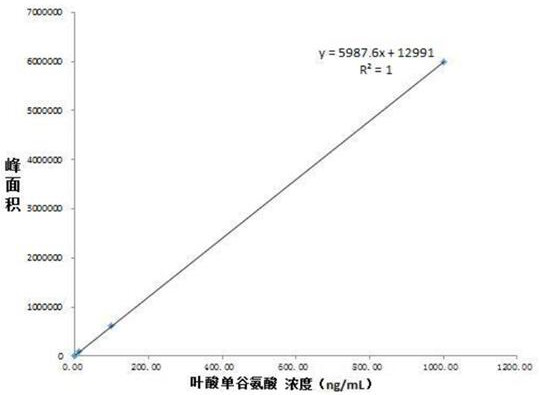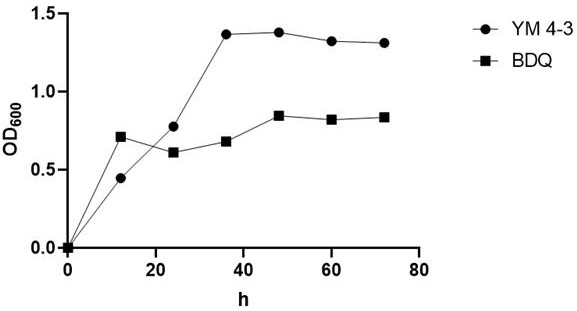Application of pyrophosphatase gene
A pyrophosphatase and gene technology, applied in the field of microbial gene application, can solve the problems of restricting the large-scale application of lactic acid bacteria, high extraction and purification costs, and low folic acid synthesis amount.
- Summary
- Abstract
- Description
- Claims
- Application Information
AI Technical Summary
Problems solved by technology
Method used
Image
Examples
Embodiment 1
[0016] Example 1: Pyrophosphatase synthetic gene fol Q clone
[0017] Design primers based on YM-4-3 genome sequence, using high-fidelity Taq enzyme pair wxya The gene was amplified by PCR (see Table 1 for the amplification system). After the amplified product was obtained, the poly A tail was connected to its 3' end (product 14.5 μL, Taq buffer 2 μL, dNTP 3 μL, Taq enzyme 0.5 μL, 72°C reaction for 15 minutes), the amplification primers are as follows:
[0018] BDQF: TCCCCCGGGAACAGGCTGGTTGGC;
[0019] BDQR: AACTGCAGTCCGTTGCTTGTGCT;
[0020] Table 1 The PCR amplification system is as follows (50 μL):
[0021] ;
[0022] Amplification conditions: pre-denaturation at 95°C for 3 min; denaturation at 95°C for 15 s; annealing at 55°C for 15 s; extension at 72°C for 1 min; cycle 30 times, and finally extension at 72°C for 10 min; the amplified PCR products were sequenced and compared. According to the sequencing results, a 588bp long sequence was obtained, and the nucleotid...
Embodiment 2
[0023] Example 2: Construction of YM-4-3 with plasmid pMG36e as backbone fol Q overexpression strain
[0024] 1. The target gene amplified in Example 1 fol The Q fragment and the pMG36e plasmid were Pst I. Sma Ⅰ two restriction endonucleases for digestion, the digestion system is as follows:
[0025] ;
[0026] After digestion at 37°C for 4 hours, use 2% agarose gel electrophoresis to identify, refer to the manual of the gel recovery kit to recover the enzyme digestion products, and store at -20°C.
[0027] 2. Enzyme digestion product connection
[0028] After purification, the digested product was ligated with T4 ligase, and ligated overnight at 16°C. The ligation system was as follows (10 μL):
[0029] ;
[0030] 3. Transformation of the ligation product into Escherichia coli DH5α strain and verification
[0031] 1) Take out the prepared competent E. coli DH5α from the -80°C refrigerator, and after thawing on ice, add all the ligation products that have been ...
Embodiment 3
[0045] Example 3: Determination of folic acid content and OD600 value
[0046] Take out the activated YML4-3 strain and BDQ strain, and inoculate them into 50 mL liquid MRS medium containing no antibiotics and 50 μg / mL erythromycin, respectively, and take samples every 12 h to measure the OD of the samples 600 value, and use LC-MS to measure folic acid content, the specific method is:
[0047] The bacterial liquid obtained every 12 hours was crushed using an ultrasonic breaker, and the conditions were: ultrasonic for 5 s, stop for 5 s, amplitude 30%, 10 min. After crushing, centrifuge at 4°C and 12,000 rpm / min for 3 min, and take the supernatant into a liquid phase vial for quantitative analysis by LC-Qtrap MS.
[0048] Chromatographic conditions: the sample enters the mass spectrometer through an autosampler connected to the double pass for detection; the mobile phase is A (water, containing 5 mmol / L ammonium formate) and B (methanol, containing 5 mmol / L ammonium formate), i...
PUM
 Login to View More
Login to View More Abstract
Description
Claims
Application Information
 Login to View More
Login to View More - R&D
- Intellectual Property
- Life Sciences
- Materials
- Tech Scout
- Unparalleled Data Quality
- Higher Quality Content
- 60% Fewer Hallucinations
Browse by: Latest US Patents, China's latest patents, Technical Efficacy Thesaurus, Application Domain, Technology Topic, Popular Technical Reports.
© 2025 PatSnap. All rights reserved.Legal|Privacy policy|Modern Slavery Act Transparency Statement|Sitemap|About US| Contact US: help@patsnap.com



